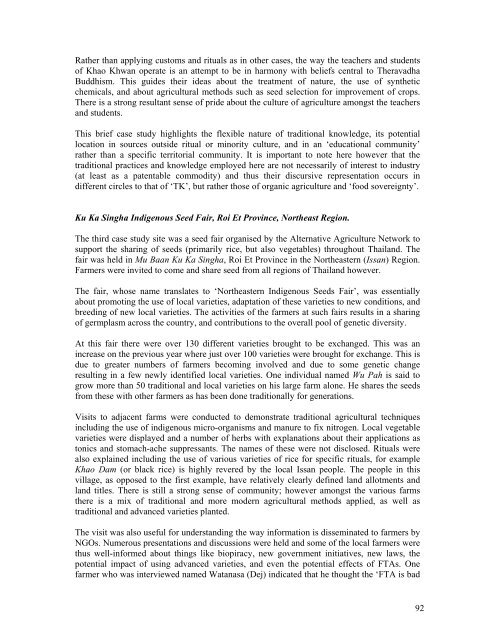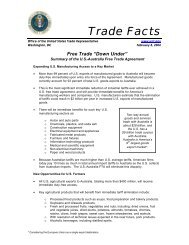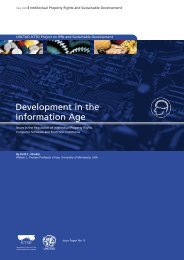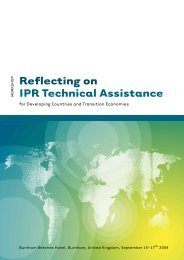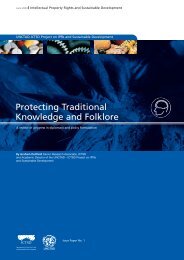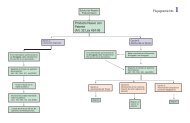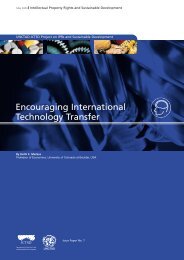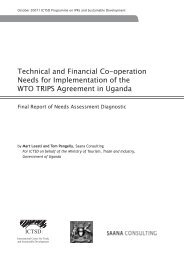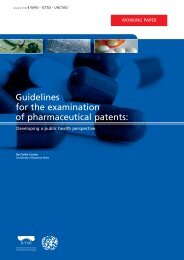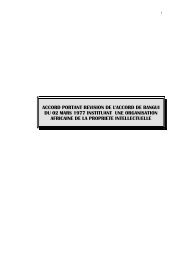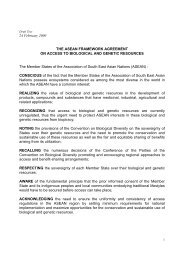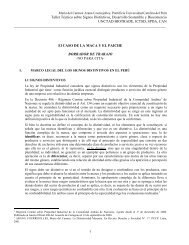Governance and Micropolitics of Traditional ... - IPRsonline.org
Governance and Micropolitics of Traditional ... - IPRsonline.org
Governance and Micropolitics of Traditional ... - IPRsonline.org
You also want an ePaper? Increase the reach of your titles
YUMPU automatically turns print PDFs into web optimized ePapers that Google loves.
Rather than applying customs <strong>and</strong> rituals as in other cases, the way the teachers <strong>and</strong> students<br />
<strong>of</strong> Khao Khwan operate is an attempt to be in harmony with beliefs central to Theravadha<br />
Buddhism. This guides their ideas about the treatment <strong>of</strong> nature, the use <strong>of</strong> synthetic<br />
chemicals, <strong>and</strong> about agricultural methods such as seed selection for improvement <strong>of</strong> crops.<br />
There is a strong resultant sense <strong>of</strong> pride about the culture <strong>of</strong> agriculture amongst the teachers<br />
<strong>and</strong> students.<br />
This brief case study highlights the flexible nature <strong>of</strong> traditional knowledge, its potential<br />
location in sources outside ritual or minority culture, <strong>and</strong> in an ‘educational community’<br />
rather than a specific territorial community. It is important to note here however that the<br />
traditional practices <strong>and</strong> knowledge employed here are not necessarily <strong>of</strong> interest to industry<br />
(at least as a patentable commodity) <strong>and</strong> thus their discursive representation occurs in<br />
different circles to that <strong>of</strong> ‘TK’, but rather those <strong>of</strong> <strong>org</strong>anic agriculture <strong>and</strong> ‘food sovereignty’.<br />
Ku Ka Singha Indigenous Seed Fair, Roi Et Province, Northeast Region.<br />
The third case study site was a seed fair <strong>org</strong>anised by the Alternative Agriculture Network to<br />
support the sharing <strong>of</strong> seeds (primarily rice, but also vegetables) throughout Thail<strong>and</strong>. The<br />
fair was held in Mu Baan Ku Ka Singha, Roi Et Province in the Northeastern (Issan) Region.<br />
Farmers were invited to come <strong>and</strong> share seed from all regions <strong>of</strong> Thail<strong>and</strong> however.<br />
The fair, whose name translates to ‘Northeastern Indigenous Seeds Fair’, was essentially<br />
about promoting the use <strong>of</strong> local varieties, adaptation <strong>of</strong> these varieties to new conditions, <strong>and</strong><br />
breeding <strong>of</strong> new local varieties. The activities <strong>of</strong> the farmers at such fairs results in a sharing<br />
<strong>of</strong> germplasm across the country, <strong>and</strong> contributions to the overall pool <strong>of</strong> genetic diversity.<br />
At this fair there were over 130 different varieties brought to be exchanged. This was an<br />
increase on the previous year where just over 100 varieties were brought for exchange. This is<br />
due to greater numbers <strong>of</strong> farmers becoming involved <strong>and</strong> due to some genetic change<br />
resulting in a few newly identified local varieties. One individual named Wu Pah is said to<br />
grow more than 50 traditional <strong>and</strong> local varieties on his large farm alone. He shares the seeds<br />
from these with other farmers as has been done traditionally for generations.<br />
Visits to adjacent farms were conducted to demonstrate traditional agricultural techniques<br />
including the use <strong>of</strong> indigenous micro-<strong>org</strong>anisms <strong>and</strong> manure to fix nitrogen. Local vegetable<br />
varieties were displayed <strong>and</strong> a number <strong>of</strong> herbs with explanations about their applications as<br />
tonics <strong>and</strong> stomach-ache suppressants. The names <strong>of</strong> these were not disclosed. Rituals were<br />
also explained including the use <strong>of</strong> various varieties <strong>of</strong> rice for specific rituals, for example<br />
Khao Dam (or black rice) is highly revered by the local Issan people. The people in this<br />
village, as opposed to the first example, have relatively clearly defined l<strong>and</strong> allotments <strong>and</strong><br />
l<strong>and</strong> titles. There is still a strong sense <strong>of</strong> community; however amongst the various farms<br />
there is a mix <strong>of</strong> traditional <strong>and</strong> more modern agricultural methods applied, as well as<br />
traditional <strong>and</strong> advanced varieties planted.<br />
The visit was also useful for underst<strong>and</strong>ing the way information is disseminated to farmers by<br />
NGOs. Numerous presentations <strong>and</strong> discussions were held <strong>and</strong> some <strong>of</strong> the local farmers were<br />
thus well-informed about things like biopiracy, new government initiatives, new laws, the<br />
potential impact <strong>of</strong> using advanced varieties, <strong>and</strong> even the potential effects <strong>of</strong> FTAs. One<br />
farmer who was interviewed named Watanasa (Dej) indicated that he thought the ‘FTA is bad<br />
92


